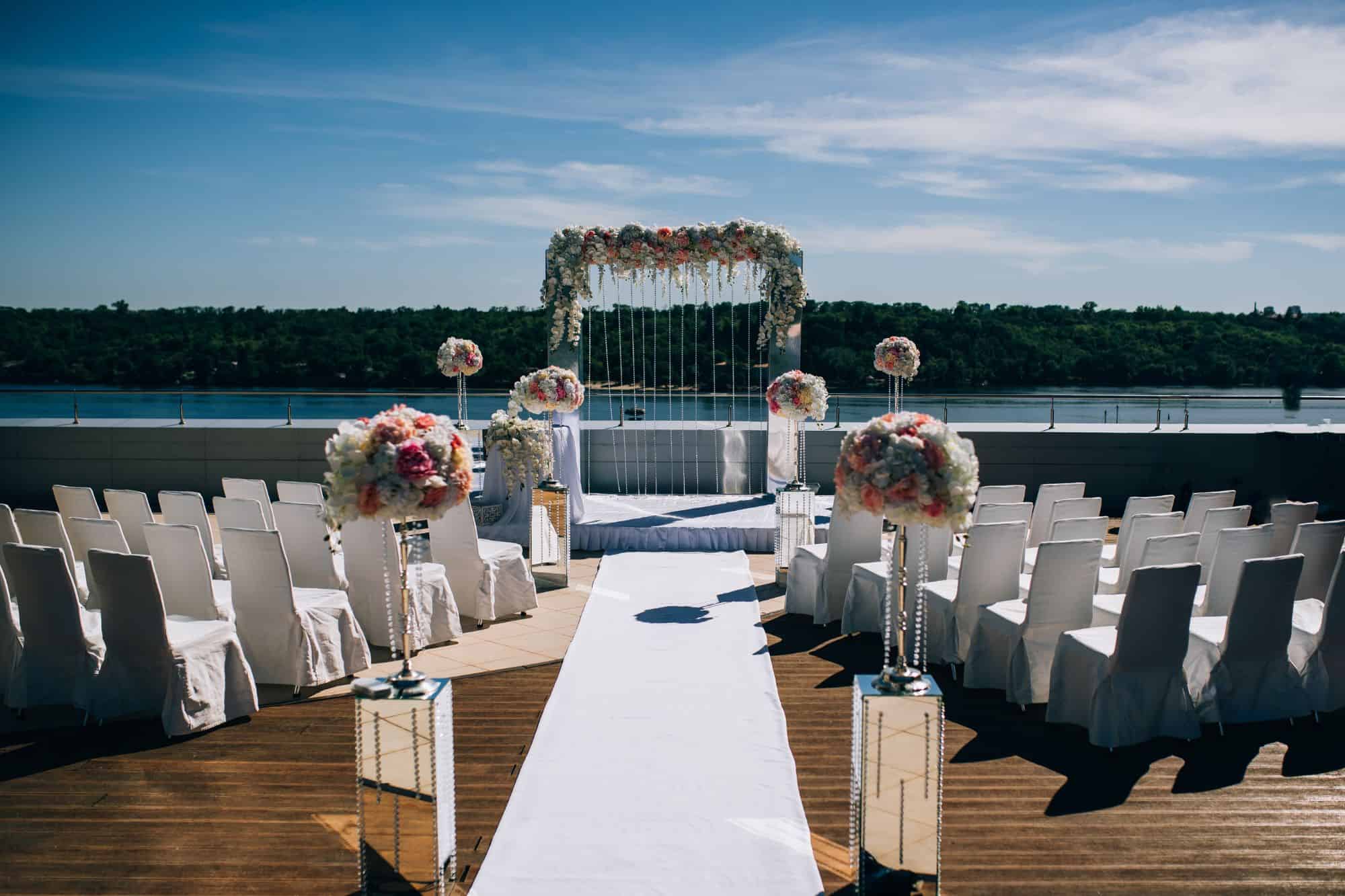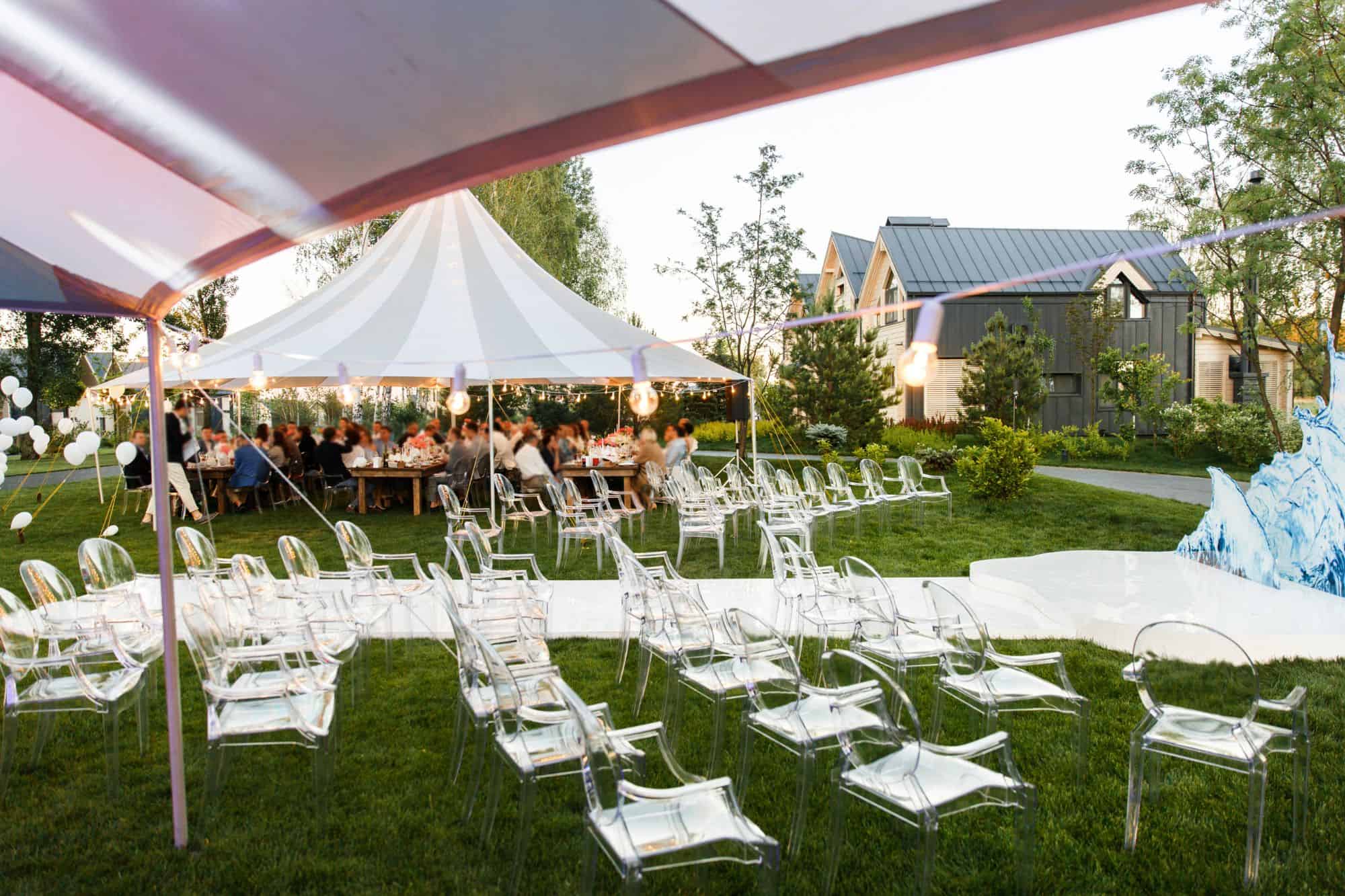Planning the perfect outdoor wedding venue requires careful consideration of both aesthetic and practical elements.
The venue should highlight the beauty of the natural surroundings while ensuring guests’ comfort and convenience.
By thoughtfully merging nature with smart design, you can create an unforgettable experience for everyone.
Let’s get straight to the point
Creating the perfect outdoor wedding venue requires thoughtful planning, from choosing a location that complements the wedding theme to considering weather, accessibility, and guest comfort.
Design the layout to allow smooth movement, use appropriate décor and lighting, and offer a weatherproof menu. Plan sound and music carefully, ensuring the system suits the outdoor space.
Always have backup plans for unexpected weather or wildlife. Collaborate with experienced vendors and stay flexible to handle challenges, ensuring a beautiful, memorable wedding day.
1. Choose the Right Location
Embrace Nature
Your location should complement the wedding theme. Whether it’s a beach, garden, or countryside, align your venue choice with the atmosphere you want to create. A beach is perfect for a relaxed vibe, while a garden suits a fairy-tale setting.
Consider the Weather
Weather is unpredictable. Research local conditions for your wedding date and have a backup plan, such as renting a tent or having an indoor space ready in case of rain or extreme heat.
Budget Considerations
Some outdoor venues come with natural beauty that reduces the need for extra décor, but don’t forget to factor in costs for essentials like tents, climate control, and transport. Stay within your budget to avoid surprises.
Accessibility and Convenience
Ensure your venue is easy to reach, close to accommodation, and offers ample parking. It should also be accessible to all guests, including those with mobility issues.
Venue Size and Capacity
Make sure the venue can accommodate your guest list comfortably. Plan for flexibility in layout, allowing space for the ceremony, reception, and other activities.
Additional Services and Amenities
Check if the venue offers services like catering, lighting, or event coordination. On-site amenities such as accommodation and sound equipment can make planning easier.
Visit in Advance
Visit the venue at the same time of year as your wedding date to assess lighting, atmosphere, and any potential issues, like noise or privacy.
Read Reviews and Get Recommendations
Research feedback from other couples who used the venue. Reviews can reveal important details and help you choose a reliable location.
2. Design the Perfect Layout and Décor
Create a Smooth Layout
Ensure a natural flow between the ceremony, reception, and other areas. Guests should be able to move around easily without feeling crowded.
Lighting and Ambience
Lighting is key for evening events. Use string lights, lanterns, and candles to create a warm atmosphere. Make sure all pathways and key areas are well-lit for safety.
Décor and Floral Arrangements
Choose décor that enhances the natural beauty of your venue. Seasonal flowers work well, whether wildflowers for a meadow or tropical blooms for a beach. Opt for sustainable décor, like potted plants, to minimize environmental impact.
Guest Comfort and Accessibility
Make sure guests are comfortable by providing practical items like sunscreen, bug spray, or blankets, depending on the weather. Ensure clear signage and accessible restrooms.
Personalised Touches
Incorporate personal elements like custom signs or photo displays to make your wedding unique and meaningful for both you and your guests.
Collaborate with Professionals
Work with vendors experienced in outdoor weddings. A skilled planner, florist, or caterer can help you navigate challenges and bring your vision to life.
3. Plan the Music and Sound
Live Music vs. Recorded Music
Decide whether you prefer live music, like an acoustic guitarist, or a curated playlist with a DJ. Both have advantages—live music adds a special touch, while recorded tracks offer more variety.
Sound System Setup
Work with a professional to ensure the sound system covers the venue and stays unobtrusive. Use wireless microphones for speeches, and place speakers strategically for clear sound.
Ceremony Music Choices
Select music that enhances the emotional moments, like the processional or recessional. Ensure the music fits the atmosphere and highlights the significance of each moment.
Reception Music
Whether you choose a band or DJ, ensure the reception music encourages celebration. Plan different music for various parts of the day, from cocktails to dinner and dancing.
Plan for Weather
Protect sound equipment from unexpected weather. Discuss backup options with your vendors to prevent disruptions.
Volume and Local Regulations
Keep sound levels within local noise ordinances. Ensure your music enhances the celebration without disturbing neighbours or violating regulations.
4. Food and Beverage Planning
Weatherproof Menu
Choose food that can withstand weather conditions. Offer options suitable for all diets, and keep the food properly covered to protect it from the elements.
Work with Experienced Caterers
Select a caterer experienced with outdoor events. They’ll know how to handle limited kitchen facilities and ensure food safety, while creating a menu that complements the setting.
Set Up Adequate Kitchen Facilities
Ensure proper equipment is available for food preparation. Mobile kitchens or extra tools might be needed to maintain food quality.
Use Seasonal and Local Ingredients
Opt for seasonal and local ingredients for fresher, more sustainable menu choices. Work with your caterer to create a farm-to-table experience.
Beverage Options
Offer a variety of drinks, including non-alcoholic options. Ensure beverages are kept cool and easily accessible. Set up drink stations around the venue for convenience.
Efficient Service
Ensure you have enough staff to serve guests efficiently. A seamless dining experience will keep everyone happy and comfortable.
Venue Layout for Catering
Design the venue layout to ensure smooth food service. Keep reception and kitchen areas close, or set up food stations to ease congestion.
Consider Dietary Restrictions
Offer vegetarian, vegan, and gluten-free options. Collaborate with your caterer to ensure all guests have satisfying, delicious food.
5. Prepare for the Unexpected
Weather Contingency Plans
Always have a plan B for bad weather. A tent or alternative indoor space can prevent a weather surprise from ruining your day.
Be Aware of Wildlife
In outdoor settings, wildlife and insects may show up. Be prepared to manage these surprises with insect repellent or professional help, if needed.
Stay Flexible
Outdoor weddings come with challenges. Stay flexible and embrace unexpected moments—they may become some of the most memorable parts of your day.
Conclusion
Creating the perfect outdoor wedding venue involves balancing beauty and practicality. By choosing the right location, designing an inviting layout, and preparing for the unexpected, you’ll ensure your outdoor wedding is both beautiful and memorable.
Thoughtful planning and collaboration with experienced professionals will help you create a wedding day that reflects your personality and delights your guests.
Frequently Asked Questions
How Do I Choose The Best Location For My Outdoor Wedding?
The key to choosing the best location is to consider what backdrop you envision for your special day, along with practical aspects such as accessibility for guests, available amenities, and the natural landscape’s compatibility with your wedding theme.
Research various types of venues, from beaches to forests, and visit your top choices in person to get a feel for the space.
Additionally, consider the season and typical weather conditions to ensure your chosen location will offer the setting and comfort you desire.
What Are The Most Important Weather Contingencies To Plan For An Outdoor Wedding?
Weather can be unpredictable, so it’s crucial to have a solid plan for various scenarios. The most important contingencies include a plan for rain, such as having tents or an indoor backup space.
Also, consider extreme heat or cold by providing amenities like fans, portable heaters, or blankets. Lastly, have a strategy for wind, which might involve securing decorations and choosing wind-resistant floral arrangements.
How Can I Decorate My Outdoor Wedding Venue To Match My Theme Without Overshadowing The Natural Beauty?
To complement the natural beauty of your outdoor venue while highlighting your theme:
- Focus on decorations that enhance rather than compete with the surroundings.
- Use elements like string lights, lanterns, and floral arrangements that blend with the landscape.
- Choose a colour palette harmonising with the setting and incorporating natural materials like wood and stone.
Less is often more in outdoor settings, so let the venue’s inherent beauty shine through.
What Are Some Guest Comfort Considerations For An Outdoor Wedding?
Guest comfort should be a top priority to ensure everyone enjoys your special day.
Protect against the elements, such as sunscreen and parasols for sunny days or cozy blankets for cooler evenings.
Ensure ample seating and hydration stations, and consider the terrain when advising guests on appropriate footwear.
If your venue is in a remote location, provide clear directions and possibly transportation to make the journey as smooth as possible.
How Do I Deal With Potential Outdoor Wedding Logistics Like Power And Lighting?
Addressing logistics such as power and lighting is essential for a seamless outdoor wedding. For power, you may need to rent generators to support lighting, music, and catering needs.
When planning your lighting, aim for solutions that enhance the ambience while providing sufficient illumination for safety and comfort, such as fairy lights, lanterns, and strategically placed spotlights.
Always consult with your vendors about their power requirements and conduct a site visit to plan the setup effectively.



